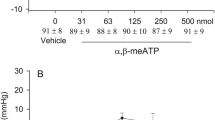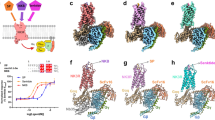Abstract
Although the opioid peptide dynorphin contains the pentapeptide Leu-enkephalin as its amino-terminal sequence1, the two opioid peptides differ in their potency and sensitivity to antagonism by the specific opiate antagonist naloxone. In the guinea pig myenteric plexus–longitudinal muscle assay, dynorphin(1–13) is 700 times more potent and 13 times less sensitive to naloxone antagonism than Leu-enkephalin1. We have identified the specific amino acids in the dynorphin(6–13) sequence responsible for this higher potency2. One explanation for the difference in naloxone sensitivities is that dynorphin and Leu-enkephalin act through different types of opiate receptors, as first suggested by Goldstein et al.1. This hypothesis has been strongly supported by recent results3 showing that vasa deferentia of mice infused with both D-Ala2-D-Leu5-enkephalin (DADLE) and the opiate alkaloid sulfentanil become tolerant to the effects of Leu-enkephalin and sulfentanil, whereas sensitivity to dynorphina(1–13) remains unchanged. Here we report that the guinea pig ileum myenteric plexus contains two physically distinct classes of opiate receptors: the μ receptor, with which leu-enkephalin (or normorphine) interacts, and a separate dynorphin receptor.
This is a preview of subscription content, access via your institution
Access options
Subscribe to this journal
Receive 51 print issues and online access
$199.00 per year
only $3.90 per issue
Buy this article
- Purchase on Springer Link
- Instant access to full article PDF
Prices may be subject to local taxes which are calculated during checkout
Similar content being viewed by others
References
Goldstein, A., Tachibana, S., Lowney, L. I., Hunkapiller, M. & Hood, L. Proc. natn. Acad. Sci. U.S.A. 76, 6666–6670 (1979).
Chavkin, C. & Goldstein, A. Soc. Neurosci. Abstr. 6, 617 (1980).
Wuster, M., Schulz, R. & Herz, A. Neurosci. Lett. 20, 79–83 (1980).
Portoghese, P. S., Larson, D. L., Jiang, J. B., Caruso, T. P. & Takemori, A. E. J. med. Chem 22, 168–173 (1979).
Caruso, T.P., Larson, D. L., Portoghese, P. S. & Takemori, A. E. J. Pharmac. exp. Ther. 213, 539–544 (1980).
Schulz, R. & Goldstein, A. Br. J. Pharmac. 48, 655–666 (1973).
Goldstein, A., Aronow, L. & Kalman, S. M. Principles of Drug Action, 82–104 (Wiley, New York, (1974).
Rocha e Silva, M. Eur. J. Pharmac. 6, 294–302 (1969).
Creese, I. & Snyder, S. H. J. Pharmac. exp. Ther. 194, 205–219 (1975).
Kosterlitz, H. W. & Paterson, S. J. Proc. R. Soc. B210, 113–122 (1980).
Robson, L. E. & Kosterlitz, H. W. Proc. R. Soc. B205, 425–432 (1979).
Smith, J. R. & Simon, E. J. Proc. natn. Acad. Sci. U.S.A. 77, 281–284 (1980).
Author information
Authors and Affiliations
Rights and permissions
About this article
Cite this article
Chavkin, C., Goldstein, A. Demonstration of a specific dynorphin receptor in guinea pig ileum myenteric plexus. Nature 291, 591–593 (1981). https://doi.org/10.1038/291591a0
Received:
Accepted:
Issue Date:
DOI: https://doi.org/10.1038/291591a0
This article is cited by
-
Behavioral Stress May Increase the Rewarding Valence of Cocaine-Associated Cues Through a Dynorphin/κ-Opioid Receptor-Mediated Mechanism without Affecting Associative Learning or Memory Retrieval Mechanisms
Neuropsychopharmacology (2010)
-
Addictive evaluation of cholic acid-verticinone ester, a potential cough therapeutic agent with agonist action of opioid receptor
Acta Pharmacologica Sinica (2009)
-
Human endometrium as a neuroendocrine tissue: Expression, regulation and biological roles of endometrial corticotropin-releasing hormone (CRH) and opioid peptides
Journal of Endocrinological Investigation (1997)
Comments
By submitting a comment you agree to abide by our Terms and Community Guidelines. If you find something abusive or that does not comply with our terms or guidelines please flag it as inappropriate.



